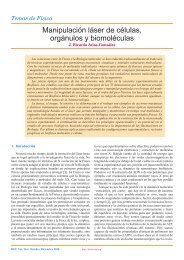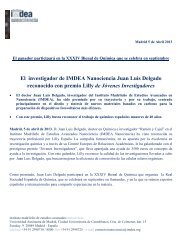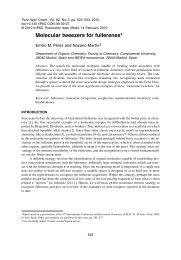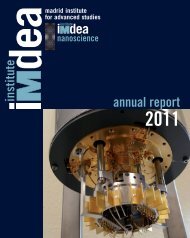Energy, supramolecular chemistry, fullerenes, and the sky* - IMDEA ...
Energy, supramolecular chemistry, fullerenes, and the sky* - IMDEA ...
Energy, supramolecular chemistry, fullerenes, and the sky* - IMDEA ...
- No tags were found...
Create successful ePaper yourself
Turn your PDF publications into a flip-book with our unique Google optimized e-Paper software.
<strong>Energy</strong>, <strong>chemistry</strong>, <strong>fullerenes</strong>, <strong>and</strong> organic solar cells 205increasing concentration of C 60 . Besides this, after subtraction of <strong>the</strong> absorption of fullerene, weobserved <strong>the</strong> concomitant appearance of a charge-transfer b<strong>and</strong> at λ = 482 nm. Fluorescence emissionspectra recorded in <strong>the</strong> course of <strong>the</strong> titration resulted in mirror images of <strong>the</strong> absorption spectra. Theintensity of <strong>the</strong> weak emission of exTTF (λ max = 470 nm; Φ = 10 –3 ) is reduced on addition of C 60 , whilea new emission centered at 557 nm increases at its expense. Nonlinear regression of <strong>the</strong>se spectralchanges allowed us to estimate binding constants in <strong>the</strong> range of log K a = 3–4.Fig. 2 (a) Structures of <strong>the</strong> tweezers-like receptors 1 <strong>and</strong> 2. (b) <strong>Energy</strong>-minimized (BH&H) geometries of <strong>the</strong>ircomplexes with C 60 . (c) Experimental (top, MALDI-TOF) <strong>and</strong> <strong>the</strong>oretical (bottom), mass spectrum of 2 C 60 . (d)Fluorescence spectra (PhCN, 298 K) of 1 with increasing concentration of C 60 ; <strong>the</strong> arrows indicate <strong>the</strong> progressionof <strong>the</strong> titration.Distinctively, exTTF <strong>and</strong> C 60 are complementary not only in a <strong>supramolecular</strong> sense, but alsoelectronically. Both fragments were known to undergo photoinduced electron transfer (PET) fromexTTF to C 60 in covalently connected conjugates [66]. A prerequisite for <strong>the</strong> newly developedexTTF-C 60 <strong>supramolecular</strong> systems to find application in OSCs is that PET takes place in solution.Such possibility was investigated in collaboration with <strong>the</strong> group of Prof. Dirk M. Guldi. We were gladto observe that intracomplex PET does occur from <strong>the</strong> exTTF units of <strong>the</strong> receptor <strong>and</strong> <strong>the</strong> bound C 60 .The charge-separated states are relatively short-lived, with lifetimes in <strong>the</strong> range of picoseconds, whichcan be readily understood considering that binding of C 60 by ei<strong>the</strong>r 1 or 2 implies some degree of orbitaloverlap between <strong>the</strong> electroactive units, which facilitates both charge separation <strong>and</strong> charge recombinationprocesses [70].With <strong>the</strong>se results in h<strong>and</strong>, we anticipated that increasing <strong>the</strong> preorganization in our receptors<strong>and</strong>/or increasing <strong>the</strong> number of exTTF units should lead to improved binding constants. In this sense,our first attempt was to syn<strong>the</strong>size <strong>the</strong> analogue of 1 featuring three exTTF units, utilizing trimesic acidas a spacer. Despite <strong>the</strong> additional recognizing fragment, we found a very modest increase in stabilityof <strong>the</strong> associates compared to <strong>the</strong> tweezers 1 <strong>and</strong> 2, with binding constants in <strong>the</strong> order of log K a = 4,© 2010, IUPAC Pure Appl. Chem., Vol. 83, No. 1, pp. 201–211, 2011







